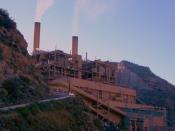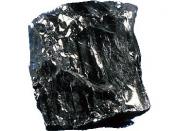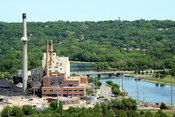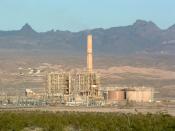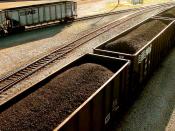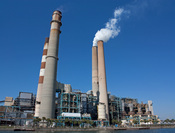300,000 million years ago plants and trees from the Jurassic and Cretatious eras began to decay. The remains of the decay, called Biomass, sunk into the ground and created a new material called peat. After lots of intense pressure the peat became so dense that coal was produced. When coal is burned it gives off heat which can be used to create energy.
Coal is the most abundant fuel source in America. A typical 500 megawatt coal plant can burn 1.4 million tons of coal each year. Six hundred of those coal plants can be found all around the U.S. Burning coal produces smog, soot, acid rain, greenhouse gasses (like carbon dioxide), toxic chemicals (that can contaminate drinking water) and ash. That is why for the past 50 years scientists have been trying to find a more efficient way of using coal energy.
The Future of Coal-The use of coal for generating electricity has nearly tripled in the last 30 years.
Coal generates 54% of our electricity, but it is the single biggest air polluter in the U.S.
The waste produced from coal can be such a hassel that some scientist say that we should just stop using coal entirely. Science facilities all around the world have been searching for a better way to use coal. One example is the use of steam. Used in the late 1800sÃÂ steam engines work by using coal to produce steam which powers the engine by spinning the piston. A new prosses called ÃÂgasificationÃÂ takes all the pollutants of coal out, so that when it is burned all that is realeased is steam. That steam can be used by a second engine to produce double the energy that coal would have before. Other technologies have been found to extract CO2 from coal and bury it into the ground or add it to oil fields to enhance oil recoverly. Some researchers say that it would be more efficient to build newer plants that can heat the coal in such a way that the coal would become a gas and then burned for fuel. Since the 1920sÃÂ the U.S. has been using a method called the ÃÂFisher-Tropsch methodÃÂ or F-T for short. This method melts coal into a liquid and uses it as a substitute for diesel, natural gas, jet fuel and other oil based products. The Fisher-Tropsch method has been used by the U.S. mainly as a fallback when oil production has been low. Several oil companies like Shell, Exxon and StatoiHydro have already been conducting experiments of their own using the Fisher-Tropsch method. Adding other biomasses to coal can create hydrogen fuel producing more energy.
The future is always indefinite, but the points written in this report show that it is most likely for coal production to contunue, using different methods of burning and utilizing coal. Some scientists predict that we will run out of coal in the near future. The fact of the matter is that the earth is abundant with coal and we will probubly not run out of it any time soon. Coal has a bright future in the western world.
Work CitiedBullis, Kevin. "The Precarious Future of Coal." MIT Technology Review. 14 Mar.
2007. Massachusetts Institute of Technology. 28 Feb. 2009 .
